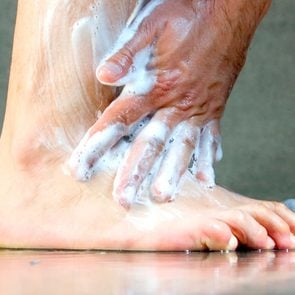A Woman in Her 20s Shares What It’s Like to Have Diabetic Foot Problems
Updated: Jun. 30, 2022
After a childhood diabetes diagnosis, one woman shares how she learned the hard way about the foot problems that can accompany diabetes—and the steps she takes to stop them from coming back.

Diabetic foot problems are not confined to older people who have had diabetes for decades. According to a study in Diabetes Care, the prevalence of diabetic peripheral neuropathy in young people with diabetes approaches rates of neuropathy in adults with diabetes. All that to say, keeping your feet healthy is especially critical with a diabetes diagnosis—even if that diagnosis happens at a young age.
When Davina Price, 22, was diagnosed with type 1 diabetes just after turning 10 years old, her doctors were focused on the “more serious” diabetes complications than on educating her about foot care. What followed was a decade of pain, infections, and numbness. Here, Price shares how she has overcome each setback and is focused on controlling her diabetes and living a healthy life.
A type 1 diabetes diagnosis
When I was diagnosed with type 1 diabetes just five days after my tenth birthday, everyone in my family was shocked. My illness progressed so fast; over the course of just one week I started vomiting after every meal and then after every drink. At one point, I couldn’t get out of bed, and then we had to call an ambulance because I was having chest pain. I don’t remember much after that, besides waking up in the hospital the following day and my dad telling me that I was diabetic.
My nan worked as a nurse in the diabetes ward of a hospital back in the mid-’60s, so we had some idea of the possible complications I might experience. But it wasn’t until I was discharged and we met with my care team that we learned about all of them. Back then, my team would focus on the “big ones” like organ failure and retinopathy, not so much on the possible foot problems.
Dealing with foot skin infections
The first time I really found out about foot care was when I had my first infection. As a child, I used to chew my toenails (a disgusting habit I have now broken), and when I did, bacteria from my mouth would cause skin infections on my toes. My doctor explained that as someone with diabetes, I was at a higher risk for these infections and that I needed to be extra careful. I was able to kill the habit, but not before it caused some serious ingrown toenails.
As a teenager, I needed to get my ingrown toenails surgically removed twice because they had grown so far into the skin and were causing dangerous and painful infections—the doctors removed a third of an inch of the nail from my right big toe and even more from my left big toe.
For the second procedure, because I didn’t have good control over my blood sugar, I had to go and see a nurse for dressing changes every day for the first week post-op and then twice more afterward. This was to ensure that any signs of infection would be caught early.
My toes stay pretty clear of infections these days now that my toenails are growing properly, but I always have a pack of antibiotics on hand in case one pops up.
A feeling of numbness
Last year, I started working as a passenger service assistant at the local airport. I would do the commute in sneakers, but once I was at work, I was walking up to 35,000 steps a day in heels. We were allowed to wear flat shoes, but the restrictions on which ones were allowed with uniforms meant it was much easier to get heels.
I was only there from February to October as a seasonal worker, but I went through four pairs of shoes. I would work six days in a row then have three days off. (Here are the best diabetic shoes for women.)
In May, I started getting pins and needles in the toes of my right foot towards the end of my work week, but it would clear up after three days of not wearing my work shoes.
However, with each week that passed the tingling lasted longer until it turned to numbness on the tip of the right big toe and extended down towards the base.
By September, I couldn’t feel any pressure on most of my big toe. I was hospitalized two separate times due to stress pains and was diagnosed with diabetic neuropathy. The truth is my blood sugar was not well controlled at the time, and the doctors suspected it was the cause of the numbness.
I left my job at the airport and put away my heels and after about four months the numbness had mostly disappeared. (Try one of these shoes for neuropathy.)
Living healthy with diabetes
These days, I take multiple steps to keep my foot problems in check. I wear clean socks or tights every single day and I wash my slippers at least once a month. I make sure that all my shoes (which are almost all flats) fit well and don’t rub anywhere on my feet—any pair that causes blisters more than twice gets thrown away. I use clippers to keep my toenails clean and short.
While I haven’t had it in years, I had athlete’s foot as a child and absolutely nothing would get rid of the fungus; the only fix was getting my blood sugar under control so there wouldn’t be any excess sugar for the fungus to feed off of.
So after bathing, I make sure that my foot is fully dry, including between the toes, before putting on socks to help avoid fungal infections.
And of course, I do my best to maintain good blood sugar control. Every form of routine in my life disappeared at the start of the Covid-19 pandemic, which made it extra difficult to keep my blood sugar in check.
But I’ve started setting an alarm on my phone each day to remember to test my levels and take my insulin. Control over my life is returning. I also blog about my day-to-day experiences with my diabetes at Diabetic Duck, where I share my thoughts and try to enlighten others about what it’s like to live with diabetes.
(Next, read how one woman with diabetes almost had a leg amputation due to complications of an ant bite.)
—As told to Alyssa Sybertz



